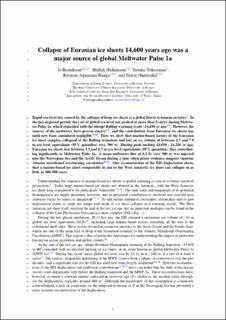Eurasian Ice Sheet collapse was a major source of Meltwater Pulse 1A 14,600 years ago
Journal article, Peer reviewed
Accepted version

View/
Date
2020Metadata
Show full item recordCollections
- Department of Earth Science [1050]
- Registrations from Cristin [9791]
Abstract
Rapid sea-level rise caused by the collapse of large ice sheets is a threat to human societies. In the last deglacial period, the rate of global sea-level rise peaked at more than 4 cm yr−1 during Meltwater Pulse 1A, which coincided with the Bølling warming event some 14,650 years ago. However, the sources of the meltwater have proven elusive, and the contribution from Eurasian ice sheets has been considered negligible. Here, we present a regional carbon-14 calibration curve for the Norwegian Sea and recalibrate marine 14C dates linked to the Eurasian Ice Sheet retreat. We find that marine-based sectors of the Eurasian Ice Sheet collapsed at the Bølling transition and lost an ice volume of 4.5–7.9 m sea-level equivalents (SLE) over 500 years. During peak melting, 3.3–6.7 m SLE of ice was lost, potentially explaining up to half of Meltwater Pulse 1A. A mean meltwater flux of 0.2 Sv over 300 years was injected into the Norwegian Sea and the Arctic Ocean at a time when proxy evidence suggests vigorous Atlantic meridional overturning circulation. Our reconstruction shows that massive marine-based ice sheets can collapse in as little as 300–500 years.